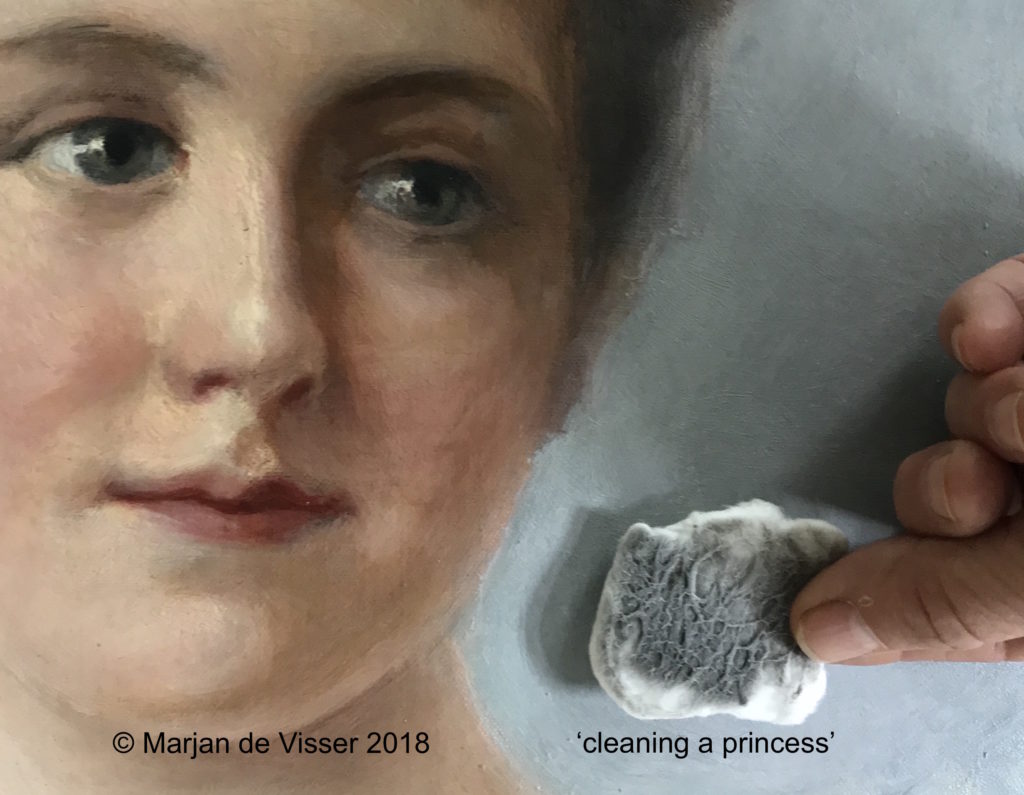Cleaning Paintings in Restauratieatelier Marjan de Visser
Cleaning paintings is an important treatment in paintings restoration. A dirty painting is not attractive. Besides this a dirty painting ages faster than a clean painting. Cleaning paintings is the biggest challenge for a painting conservator. Not only cleaning the image from dirt, dust or nicotine layers. Also cleaning the back of the stretcher and the canvas from dust, spider web and pine needles. Removing varnish also falls under painting cleaning during the conservation and restoration of paintings.
Go to the portfolio of before and after
★contact us★

Cleaning a modern painting is a real challenge
Restoring and cleaning unvarnished paintings is a specialty of Marjan de Visser. Testing and applying cleaning techniques requires insight into the materials used. So therefore the knowledge of chemistry is a must.
The importance of cleaning paintings
Cleaning paintings is important because the painting is often more beautiful after restoration. A clean painting also lasts longer. Cleaning a painting seems easy, but this is not the case. When the wrong techniques and materials are used, the paint or varnish can also be damaged. An oil painting therefore requires a completely different approach than an acrylic painting or a tempera painting. Research into the composition of the materials used prior to testing and cleaning is of great importance during painting restoration.
Cleaning paintings with the Modular Cleaning Program (The MCP)
While cleaning paintings, the composition of the dirt is an important factor in descision making. After all, the type of dirt partly determines the choice of cleaning agents. The challenge in restoration is therefore also to mix the correct cleaning agent. In Marjan de Visser her restoration studio, the restorers use The Modular Cleaning Program (the MCP). This is a method in which the dirty surface is measured for acidity (pH) and conductivity (mS). With buffers, metal binders (chelators) and soaps (surfactant) cleaning tests can be carried out quickly and easily.

Techniques and materials for cleanings paintings
The restorer can make a specific mixture for every painting that has to be cleaned. Wether it is a varnished or unvarnished paint layer. On one occasion, the restorers can choose to clean with a cotton swab or brushes. There is also using equipment that extracts the dissolved dirt. For these cases an aspirator is available, called the Aspeed. Another time, the water mixture is bound in a gel or emulsion.
Nicotine removal is like revealing a painting from a dark yellow haze.

removing soot from a old yellow varnish
The Pemulen® TR2 gel was successfully used during soot removal out of the cracks from a 18th century painting.
See this wonderful example of removing a soot layers from a varnished painting. It’s a chimneypiece by Jan Abel Wassenberg that came in the studio in 2019. Paint cross-sections showed that the painting had been varnished several times in the past. The last time was in 1953. At least the newspaper on the back has a date from March 1953. Furthermore, all kinds of exciting and special discoveries pass by. Just look at these photos. These are the first tests of dirt cleaning and varnish removal using Pemulen. Later in the cleaning process of this chimneypiece it appeared that even the cracks in the paint layer contained soot. This was the cause that the painting still looks gray after cleaning. So the last cleaning with Pemulen® TR2 gel was the magic trick.
Cleaning the backside of the canvas.
Not all cleaning operations are immediately visible. Dirt and dust removed with a vacuum cleaner and a brush doesn’t show on the image. However, this is one of the most important treatments. Preventive conservation to avoid damage by fungi and insects!







